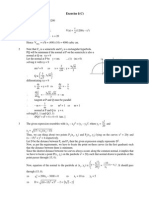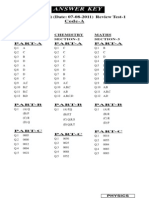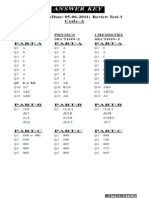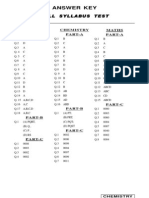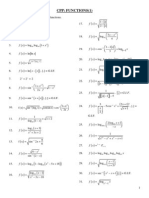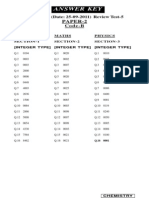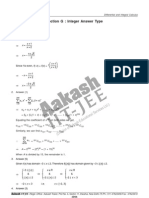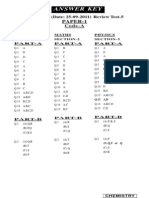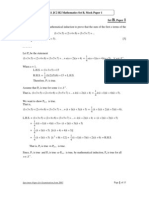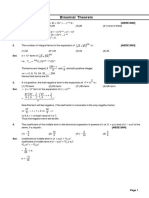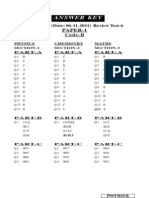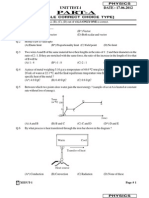RT Solutions-09!10!2011 XIII VXY Paper II Code B
RT Solutions-09!10!2011 XIII VXY Paper II Code B
Uploaded by
vishal27042233Copyright:
Available Formats
RT Solutions-09!10!2011 XIII VXY Paper II Code B
RT Solutions-09!10!2011 XIII VXY Paper II Code B
Uploaded by
vishal27042233Original Description:
Original Title
Copyright
Available Formats
Share this document
Did you find this document useful?
Is this content inappropriate?
Copyright:
Available Formats
RT Solutions-09!10!2011 XIII VXY Paper II Code B
RT Solutions-09!10!2011 XIII VXY Paper II Code B
Uploaded by
vishal27042233Copyright:
Available Formats
13
th
VXY (Date: 09-10-2011) Review Test-3
PAPER-2
Code-B
ANSWER KEY
CHEMISTRY
SECTION-2
PART-A
Q.1 C
Q.2 A
Q.3 A
Q.4 A
Q.5 C
Q.6 B
Q.7 C
Q.8 A
[Only XY Batch]
Q.9 C
Q.10 B
Q.11 A
[Only V-Group Batch]
Q.9 C
Q.10 A
Q.11 D
PART-B
[Only V-Group Batch]
Q.1 (A) P,Q,S
(B) Q,S
(C) R,S,T
(D) Q,S
[Only XY Batch]
Q.1 (A) P,R,S,T
(B) Q
(C) Q,R
(D) P,R
PART-C
Q.1 0076
[Only V-Group Batch]
Q.2 0007
[Only XY Batch]
Q.2 0006
Q.3 0088
Q.4 0001
Q.5 0008
[Only V-Group Batch]
Q.6 0523
[Only XY-Group Batch]
Q.6 2312
MATHS
SECTION-1
PART-A
Q.1 C
Q.2 A
Q.3 D
Q.4 D
Q.5 B
Q.6 A
Q.7 B
Q.8 C
Q.9 D
Q.10 B
Q.11 C
PART-B
Q.1 (A) S
(B) R
(C) S
(D) Q
PART-C
Q.1 0001
Q.2 0004
Q.3 0005
Q.4 0002
Q.5 0004
Q.6 0008
PHYSICS
SECTION-3
PART-A
Q.1 C
Q.2 A
Q.3 C
Q.4 A
Q.5 B
Q.6 C
Q.7 B
Q.8 A
Q.9 A
Q.10 A
Q.11 A
PART-B
Q.1 (A) P,Q
(B) P,Q,R
(C) P,S,T
(D) P,Q
PART-C
Q.1 0002
Q.2 0155
Q.3 0002
Q.4 0007
Q.5 0001
Q.6 0080
MATHEMATICS
Code-B Page # 1
PART-A
Q.1
[Sol. Given, o | =
2
3t
.......(1) and = o + | ........(2)
So, tan o = |
.
|
\
|
| +
t
2
3
tan ; (From equation (1))
tan o = cot | tan o tan | + 1 = 0 .........(3)
Now, tan =
| o
| + o
tan tan 1
tan tan
(From equation (2))
tan =
2
tan tan | + o
(Using equation (3)) tan o, tan , tan | are in A.P. Ans.]
Q.2
[Sol. Given, f (x) =
}
t
x
2
dt ) t sin 2 t (cos f ' (x) = (cos x 2 sin x) < 0 in x e
(
t
t
,
2
f (x) is decreasing (+) function in
(
t
t
,
2
Hence,
greatest
2
x f
|
.
|
\
| t
=
=
}
t
t
2
2
dx ) t sin 2 t (cos = 0. ]
Q.3
[Sol. Clearly ,
( )
( ) ) 1 ( f 1 h 2 h 2 f
) 2 ( f 2 h 3 h f
Lim
2
3
0 h
+
+ +
=
( )
( ) h 4 2 ) 1 h 2 h 2 ( ' f
3 h 3 ) 2 h 3 h ( ' f
Lim
2
2 2
0 h
+
+ + +
=
2 4
3 6
=
4
9
.
(Using L'Hospital rule.) Ans.]
Q.4
[Sol. Let f(x) = 2(x o) (x |) (x ); where o, | = o + 3, = o + 6
( )
|
|
|
.
|
\
|
o
+ 1
x
) x ( f
1 Lim
x
1
x
=
|
|
.
|
\
|
| o | ) x ( ) x (
) x ( f
Lim
x
e =
) x ( 2 Lim
x
e
|
= e
2 ( 3)
= e
6
. Ans.]
Q.5
[Sol. Clearly, L
1
= ( )
2
x
1
2
0 x
) x sin( Lim
= 0 and L
2
= ( ) form
x
1
Lim
0
x
2
0 x
2
|
.
|
\
|
= 1
Hence, L
1
+ L
2
= 0 + 1 = 1. Ans. ]
MATHEMATICS
Code-B Page # 2
Q.6, 7, 8
[Sol. As, f(x) be a odd cubic polynomial function, so it must be of the form, f(x) = ax
3
+ bx.
Now,
2
x
1
0 x
1
x
) x ( f
Lim
|
.
|
\
|
+
exists, hence 0
x
) x ( f
Lim
0 x
=
b = 0.
So,
2
x
1
0 x
1
x
) x ( f
Lim
|
.
|
\
|
+
= e
2
e
a
= e
2
a = 2.
Hence, f(x) = 2x
3
.
(i)
|
|
.
|
\
|
1 n
1
) n ( f
n
tan
=
|
.
|
\
|
1 n
2
1
n 2
1
tan
=
|
.
|
\
|
1 n
2
1
n 4
2
tan
=
( )
|
|
.
|
\
|
+ 1 n
2
1
1 n 4 1
2
tan
=
( ) ( )
( )
|
|
.
|
\
|
+
+
1 n
2
1
1 n 4 1
1 n 2 1 n 2
tan
=
( ) ( )
=
+
1 n
1 1
1 n 2 tan ) 1 n 2 ( tan
= [(tan
1
3 tan
1
1) + (tan
1
5 tan
1
3) + (tan
1
7 tan
1
5) +....... )] =
1 tan
2
1
t
=
4
t
.
(ii) Given, h(x) = e
x + 1
}
x
1
t
dt ) t ( f e
so, h'(x) = e
x + 1
e
x
f(x) + e
x + 1
}
x
1
t
dt ) t ( f e = e f(x) + e
x + 1
}
x
1
t
dt ) t ( f e
Hence, h'(1) = ef(1) + 0 = 2e
(iii) Given, gof(x) = x x e R
g is the inverse function of f.
Now, g(2) = a g
1
(a) = 2 f(a) = 2 2a
3
= 2 a = 1
and g(16) = b g
1
(b) = 16 f(b) = 16 2b
3
= 16 b = 2.
So,
} }
+
2
1
16
2
dx ) x ( g dx ) x ( f = 2 16 1 2 = 30. Ans.]
MATHEMATICS
Code-B Page # 3
Q.9, 10, 11
[Sol. f(x) =
< s
t
< < t
t
s <
t
x 1 ,
2
1 x 0 , x cos
2
0 x ,
2
2
2
2
(0,0)
x=
1
2
x=1
x
y
y =
2 cos x t
t
2
y =
2
t
2
y =
2
t
2
(i) As, range of f(x) =
(
t t
2 2
2
,
2
so there is only one integer in the range of f(x) i.e., 0. Clearly, f(x) is
continuous x e R.
Also, f '(0
) = f '(0
+
) = 0 and f '(1
) = f '(1
+
) = 0 f(x) is differentiable x e R
Note that f(x) is non-monotonic on R.
Also,
}
t
t
2
2
5
dx ) x ( f
=
}
t
t
t
2
2
5
2
dx
2
(4t
2
) |
.
|
\
|
t
2
2
= 8. Ans.
(ii) As, h(x) = f(x) =
2
x cos 2
t
t
, x e [0, 1]
|
.
|
\
|
2
1
h = 0 and k(x) = h
1
(x)
k'(0) =
( )
2
1
x
2
x sin
2
1
2
1
' h
1
=
|
.
|
\
|
t t
t
=
|
.
|
\
|
=
2
2
1 t
=
t
. Ans.
(iii) Given, | =
( )
|
.
|
\
| t
}
0
0
dt t
2 x sin x
Lim
x
0
2
2
0 x
=
|
|
|
|
.
|
\
|
3
x
x sin x
Lim
3
2
0 x
=
|
.
|
\
|
x
x sin
Lim 3
0 x
= 3.
Given, g(x) = 7 + 2x ln 25 5
x 1
5
2 x
= 7 + 4x ln 5
x
x
5
25
5
5
MATHEMATICS
Code-B Page # 4
g '(x) = 0 + 4 ln 5 5 n 5 25 5 n
5
5
x
x
l l
+
=
| |
x x
5 125 5 20
5
5 n
+
l
For maximum or minimum of g(x), we must have g' (x) = 0 (5
x
25) ( ) 0 5 5
) positive
Always (
x
= +
5
x
= 25 x = 2.
Also, g " (x = 2) < 0 g(x) is maximum at x = 2 = o (Given)
So,
n
0 n
1 1
=
|
|
.
|
\
|
|
+
o
=
=
=
|
.
|
\
|
=
|
.
|
\
|
+
0 n
n
n
0 n
6
5
3
1
2
1
=
+
|
.
|
\
|
+ + ........
6
5
6
5
1
2
=
6
1
1
6
5
1
1
=
= 6. Ans.]
PART-B
Q.1
[Sol.
(A) We have, f(1) =
3
1
tan
2
1
tan
3
1
cot
2
1
cot
1 1
1 1
+
+
=
3
1
tan
2
1
tan
3 tan 2 tan
1 1
1 1
+
+
=
4
4
3
t
t
= 3 Ans.
(B) We have,
2
3
cos u
2
1
sin u =
3
1
cos u
3 2
cos ) 2 3 ( u
=
2
1
sin u tan u =
3
1
u =
6
7
,
6
t t
2 solutions e [0, 2t]. Ans. ]
(C) Given, L
1
=
t
t
x
x sin
) x (
) 1 e ( x cos
Lim
x
0 x
=
t
and L
2
=
x
x 2 sin ) x 1 ( n
Lim
0 x
+
l
=
|
.
|
\
|
+
x 2
x 2 sin
2 Lim
x
) x 1 ( n
Lim
0 x 0 x
l
= 1 + 2 = 1
Now, L
1
= L
2
t
= 1
= t [] = [t] = 3 Ans.
(D) Clearly, I =
2
4
t
t
2
1
2
t
= 1.
x
t
2
t
t
2
O
y
x
Ans.]
MATHEMATICS
Code-B Page # 5
PART-C
Q.1
[Sol. For o, T
n
=
) 1 n 2 ......( 5 3 1
n
+
=
|
|
.
|
\
|
+
+
) 1 n 2 ......( 5 3 1
1 1 n 2
2
1
T
n
=
|
|
.
|
\
|
+
) 1 n 2 ......( 5 3 1
1
) 1 n 2 ......( 5 3 1
1
2
1
T
1
=
2
1
|
.
|
\
|
3
1
1
T
2
=
2
1
|
|
.
|
\
|
5 3 1
1
3
1
T
n
=
|
|
.
|
\
|
+
) 1 n 2 ......( 5 3 1
1
) 1 n 2 ......( 5 3 1
1
2
1
o = ) T ...... T T ( Lim
n 2 1
n
+ + +
=
2
1
For , t
n
=
) 2 n 2 .........( 6 4 2
) 1 n 2 .......( 5 3 1
+
=
( )
) 2 n 2 .........( 6 4 2
) 1 n 2 ( ) 2 n 2 ( ) 1 n 2 .......( 5 3 1
+
+ +
t
n
=
n 2 ......... 6 4 2
) 1 n 2 .......( 5 3 1
) 2 n 2 .........( 6 4 2
) 1 n 2 .......( 5 3 1
+
+
t
1
=
4 2
3 1
2
1
t
2
=
6 4 2
5 3 1
4 2
3 1
t
n
=
n 2 ......... 6 4 2
) 1 n 2 .......( 5 3 1
) 2 n 2 .........( 6 4 2
) 1 n 2 .......( 5 3 1
+
+
=
( )
n 2 1
n
t ...... t t Lim + + +
=
2
1
o = k
2
1
=
2
k
k = 1 Ans.]
MATHEMATICS
Code-B Page # 6
Q.2
[Sol. We have,
( )
n
x n
n
) x sin 1 ( 1
e x sin 1
Lim ) x ( f
+ +
+ +
=
( ) ( )
( ) ( )
t + t e
t =
+
t t e
=
1 n 2 , n 2 x , 1
n x ,
2
e 1
n 2 , 1 n 2 x , e
x
x
where n e I.
when x e (2nt, (2n + 1) t) 0 < sin x s 1 and x e ( ) ( ) t t n 2 , 1 x 2 1 s sin x < 0.
So, f(x) =
t =
+
t < < t
t =
+
t < <
=
< < t
t =
+
t < < t
t =
+
t
t
2 x ,
2
e 1
2 x , e
x ,
2
e 1
x 0 , 1
0 x , 1
0 x , e
x ,
2
e 1
x 2 , 1
2 x ,
2
e 1
x
x
x
x
2
Clearly, number of points of discontinuity of f(x) in [2t, 2t] = 4
i.e., x = 2t, t, t, 2t.
Note : The function f(x) is continuous at x = 0. Ans.]
Q.3
[Sol.
2
A
sin
1
=
2
1
(A
1
= 60)
2
A
sin
2
=
a 2 2
a
=
4
1
2
A
sin
3
=
a 4 2
a
=
8
1
A
1
A
1
2
A
2
2
A
2
C B
a/2 a/2
a
2a
2
A
sin
n
=
a 2 2
a
1 n
=
n
2
1
=
1 n
n
) A cos 1 (
=
=
|
|
.
|
\
|
1 n
n
2
2
A
sin 2
= |
.
|
\
|
+ + + + +
n 2 2 2 2
n
2
1
.........
8
1
4
1
2
1
2 Lim =
4
1
1
2
1
2
2
=
3
2
MATHEMATICS
Code-B Page # 7
Q.4
[Sol. f(k) = ( )
}
t
t
+ + + + + dx x sin kx 2 x sin k 2 x 2 x sin k 1 x
2 2 2
= 2 ( )
}
t
+ + +
0
2 2 2
dx x sin kx 2 x sin k 1 x = =
2
3
k 2 2
3
2
+ t +
t
}
t
0
2
dx x sin + 4k
t
t
}
0
dx x sin x
=
3
2
3
t
+ 2t + 2k
2
2
4
t
+ 4kt
f (k) =
3
2
3
t
+ t (k
2
+ 4k + 2)
Minimum at k =
a 2
b
=
t
t
2
4
= 2 Ans.
Note: Minimum value f(2) =
3
2
3
t
2t ]
Q.5
[Sol. Given,
14
x x 2 24
2
>
16
x 25
2
x
2
+ 16x 17 < 0 (x + 17) (x 1) < 0 17 < x < 1.
Largest integral value of x satisfying the given inequality is zero.
Now, we have to find range of a so that both roots of equation g(x) = 0 are less than 0.
x = 0
g(x) = x + 2ax + a 9
2 2
x
2
x
1 x-axis
Disc. = (2a)
2
4 (a
2
9) = 36 > 0
Clearly, sum of roots < 0 2a < 0 a > 0 ......(i)
and product of roots > 0 a
2
9 > 0 a < 3 or a > 3 ......(ii)
So, (i) (ii) a e (3, ).
hence, a
min.
= 4. Ans.]
Q.6
[Sol.
sks
2 value . max
2 value . min
2 2
y sin 1 x cot x tan
=
=
+ = +
tan x = 1 and sin y = 1
x = nt
4
t
Hence, x =
4
3t
,
4
t
,
4
t
,
4
3t
and y =
2
t
,
2
5t
Hence, number of ordered pairs (x, y) = 4 2 = 8. Ans.]
CHEMISTRY
Code-B Page # 1
PART-A
Q.1
[Sol. Use P
A
= C
A
RT and C
A
=
V
n
A
]
Q.2
[Sol.
P
I
I
I
The EN of P > As > Sb and the steric repulsion of bulky group (I), PI
3
has maximum bond angle ]
Q.3
[Sol. Basic strength o
p of tion Delocalisa
1
l
(i) In Pyrrole lone pair of N are involved in aromatic system.
(ii) In
N
and
N
lone pair are not involved in conjugation.
(iii) In
NH
2
lone pair are involved in conjugation number of geometrical isomerism = 2
n
. ]
Q.4
[Sol.
g 18
65 . 40
813
= 360 g Ans]
Q.5
[Sol. n is number of areas capable of showing geometrical isomers which is 2 here so 2
2
= 4 .]
Paragraph for question nos. 6 to 8
[Sol. A (g) + 2B(g) C (g) + D (g)
a b 0 0
a x b 2x x x
(i) Rate = kC
B
C
B
= [C
B
]
0
e
2k
C
B
= be
2k
b 2x = be
2k
, x =
] e 1 [
2
b
k 2
[A] = a x
) e 1 (
2
b
a C
kt 2
A
=
Ans.
(ii) 2k =
x 2 b
b
ln
t
1
t = t
1/2
, x = a/2
CHEMISTRY
Code-B Page # 2
2k =
a b
b
ln
) t (
1
2 / 1
( )
) a b (
b
ln
k 2
1
t
A
2 / 1
=
Ans.
(iii)
a b
b
ln
k 2
1
) t (
A 2 / 1
=
2 ln
k 2
1
2 / b b
b
ln
k 2
1
) t (
B 2 / 1
=
=
2 ln
k 2
1
b b
b
ln
k 2
1
=
=
2
b b
b
=
2b 2a = b
b = 2a
2
1
b
a
=
Ans. ]
[Only V-Group Batch]
Paragraph for question nos. 9 to 11
[Sol.
2H C C H H C C OMe H C C OH
O O O O
O
O O
+ +
18 18
H
+
/H O
2
H
+
/ A
MeOH
OH/A
H C C O
OH
H
O
O
O
O C
]
PART-B
[Only V-Group Batch]
Q.1
[Sol. (A) [
+ 3
Fe(EDTA)]
Fe
3+
O C
O C
OCO
OC
CH N
2
CH N
2
CH
2
CH
2
CH
2
CH
2
O
O
O
O
(i) Optically active (ii) Does not show geometrical isomersim
(iii) Maximum number of chelate rings = 5 (iv) Octahedral
(B) [Co(en)
3
]
3+
(i) Number of chelate rings = 3
(ii) Optically active
(iii) Geometrical isomerism
CHEMISTRY
Code-B Page # 3
(iv) Octahedral
(C) [Pt(en)
2
]
2+
(i) Square planar (does not show optical isomersim)
(ii) dsp
2
hybridisation
(iii) Does not show geometrical isomerism
(D) [Zn(gly)
2
] (i) sp
3
hybridisation
(ii) Tetrahedral complexes does not show geometrical isomerism ]
[Only XY Batch]
Q.1
[Sol. (A) N
2
(KK*)
*
s 2 s 2
2 2
o o
2
p 2 p 2
) (
y x
t t
HOMO
) (
2
p 2
z
+
o
LUMO
) (
*
y
*
x
p 2 p 2
+
t t
(diamagnetic)
(mixing of s and p)
(B) O
2
(KK*)
*
s 2 s 2
2 2
o o
2
p 2
) (
z
o
2
p 2 p 2
) (
y x
t t
HOMO
) (
' p 2 ' p 2
y x
+
t t
LUMO
) (
*
z
p 2
+
o
(paramagnetic)
(C) B
2
(KK*)
*
s 2 s 2
2 2
o o
HOMO
) (
y x
p 2 p 2
+
t t
LUMO
) (
z
p 2
+
o
(Mixing of s and p)
(paramagnetic)
(D) C
2
(KK*)
*
s 2 s 2
2 2
o o
HOMO
) (
2
y
2
x
p 2 p 2
+
t t
LUMO
) (
z
p 2
+
o
(Diamagnetic) ]
PART-C
Q.1
[Sol. AS
300K
= 2 15 (2 30 + 50) = 30 110 = 80 CalK
1
|
.
|
\
|
=
=
1
5
7
5
7 2
) 1 (
R
C
) ( O P
2 m
g
= 7 CalK
1
mol
1
m
P
C A
= 31 (2 7 + 7) = 10 CalK
1
mol
1
.
AS
450K
= 80 + 10ln
300
450
= 80 + 4 = 76 ]
CHEMISTRY
Code-B Page # 4
[Only V-Group Batch]
Q.2
[Sol. The EAN of central metal atom / ion is equal to the nearest inert gas atomic number 36.
(i) Ni(CO)
4
EAN = Atomic number oxidation state + 2 coordination number
= 28 0 + 2 4 = 36
(ii) Fe
2
(CO)
9
EAN =
2
bond of e 2 9 2 2 26 o + +
= 36
(iii) H[V(CO)
6
] EAN = 23 (1) + 2 6 = 36
(iv) [Fe(CO)
4
]
2
EAN = 26 (2) + 2 4 = 36
(v) Co
2
(CO)
8
EAN =
2
bond of e 2 8 2 27 o + +
= 36
(vi) [Fe(CO)
2
(NO)
2
] EAN = 26 0 + 2 2 + 3 2 = 36
[CO 2 electron donor, NO 3 electron donor]
(vii) [(q
6
C
6
H
6
)
2
Cr] EAN = 24 + 6 2 = 36 [C
6
H
6
tridentate]
(viii) [Fe(CN)
6
]
3
EAN = 26 3 2 6 = 35
(ix) [Ni(NH
3
)
6
]
2+
EAN = 28 2 + 2 6 = 38 ]
[Only XY Batch]
Q.2
[Sol. O
2
2+
, O
2
2
, B
2
2
, C
2
2
, C
2
& N
2
are diamagnetic in nature.]
Q.3
[Sol. 2C
3
H
7
MgBr +
) LR ( mol 1
OH
|
CH C CH
2
2 C
3
H
8
3.40 mol 2 mol
= 88 g ]
Q.4
[Sol.
( )
2
1
iting lim
app
k
k
k =
] NH [ k 1
] NH [ k
k
k 9 . 0
3 2
3 1
2
1
+
=
or, k
2
[NH
3
] = 0.9 + 0.9 k
2
[NH
3
]
or, 0.1 k
2
[NH
3
] = 0.9
[NH
3
] =
5
10 9
9
= 10
5
Ans.]
CHEMISTRY
Code-B Page # 5
Q.5
[Sol. Molecules do not exist due to the following reasons
PH
5
due to the absence of d- contraction
Al
2
F
6
AlF
3
is an ionic compound so it can't form dimer Al
2
F
6
PbI
4
due to the strong oxidising power of Pb
+4
and reducing nature of I.
OF
4
, HOF
4
and NCl
5
due to absence of vacant d-orbital in II
nd
period element
FeI
3
due to the strong oxidising power of Fe
+3
and reducing nature of I.
B
2
F
6
BF
3
does not dimerisize due to the strong pt-pt bond formation between B and F-atom. ]
[Only V-Group Batch]
Q.6
[Sol.
O O
2
Br
OH
O
O
C O
+
H
O
O
C OH
|-Keto acid
A
O
]
PHYSICS
Code-B Page # 1
PART-A
Q.1
[Sol.
2
f
1
= ( 1)
|
.
|
\
|
1
R
1
fM
1
=
1
eq
f
1
=
fM
1
f
2
2
+
10
1
= 2
R
) 1 (
R = 10 cm ]
Q.4
[Sol. m
1
=
1
L
m
l |
.
|
\
|
, m
2
=
2
L
m
l |
.
|
\
|
sin o =
1
h
l
h = l
1
sin o = l
2
sin |
l
1
+ l
2
= L
L
sin
sin
1
1
=
|
o
+
l
l
|
o
+
=
sin
sin
1
L
1
l
,
o + |
|
=
sin sin
sin L
2
l
|
o
sin
sin
| + o
o
=
sin sin
sin L
2
l
| + o
|
=
sin sin
sin m
m
1 ,
| + o
o
=
sin sin
sin m
m
2
Let o > |
m
1
g sin o T = m
1
a
T m
2
g sin | = m
2
a
2 1
2 1
m m
sin g m sin g m
a
+
| o
=
= 0 ]
Q.5
[Sol. v =
2
1
kx
2
=
2
1
mg x =
2
1
200
1000
1
= 0.1 J ]
PHYSICS
Code-B Page # 2
Q.7
[Sol. a
t
=
o
mg sin
2
=
3
m
2
o
a =
2
sin 3 u
1.2g =
2
sin g 3 u
sin u = 0.8
u = 53 ]
Q.8
[Sol. a =
2
60 sin g 3
mg/3
2 /3
/3
/6
60 a
C
=
4
3 g 3
6
5
=
24
g 3 15
3
mg
cos 30 + F = m
24
g 3 15
]
Q.9
[Sol. V
max
at
dx
dv
= 0
6x
2
18x + 12 = 0
x
2
3x + 2 = 0
x = 1, 2
2
2
dx
v d
= 2x 3
= 1 at x = 1 maximum
= 1 at x = 2 minimum
Motion can be oscillatory about x = 2
E < E
max
E
max
= 2 1
3
9 1
2
+ 12 = 5 J ]
Q.10
[Sol. U
min
at x
0
= 2m ]
Q.11
[Sol. a = F = 6(x
2
3x + 2)
a = 4(x
2
3x + 2) = 4((2 + y)
2
3(2 + y) + 2)
= 4(4 + y
2
+ 4y 6 3y + 2)
a = 4y
e = 2
T =
2
2t
= t sec. ]
PHYSICS
Code-B Page # 3
PART-C
Q.1
[Sol. If we rotate the coordinate system so that the ramp is "horizontal", then the free-fall acceleration will have
two components; one downward given by
' y
a = g cosu and one horizontal given by
' x
a
= g sinu . In this
frame, the initial velocity will have components given by v
y
= v
0
cosu and v
x
= v
0
sinu.
The time for each bounce is given by
t
b
=
y
y
a
v 2
=
g
v 2
0
The horizontal displacement is given by
Ax = v
x
t + 0.5a
x
t
2
Given these two equations, we can find
d
12
= v
0
sinu
|
|
.
|
\
|
g
v 2
0
+ 0.5 g sinu
2
0
g
v 2
|
|
.
|
\
|
=
g
sin v 4
2
0
u
and
d
13
= v
0
sinu
|
|
.
|
\
|
g
v 4
0
+ 0.5 g sinu
2
0
g
v 4
|
|
.
|
\
|
=
g
sin v 12
2
0
u
Since, d
23
= d
13
d
12
, the ratio
23
12
d
d
=
2
1
]
Q.2
[Sol. KE =
2
CM
2
CM
I
2
1
mv
2
1
e +
3kg
1.2kg v = 6 m/sec
=
2
1
(7.8) (5)
2
+
2
1
(4.6)R
2
2
R
5
|
.
|
\
|
=
2
1
25 12.9 = 155 J ]
Q.3
[Sol.
1
v
5 . 1
6
1
=
R
1 5 . 1
1
v
5 . 1
=
R 2
1
6
1
=
R 6
R 3
v
1
=
R 3
R 9
u
2
=
R 3
R 9
R =
R 3
R R 6
2
+
PHYSICS
Code-B Page # 4
5 . 1
R
2
=
3
32
R
2
+ 22R 48 = 0
R =
2
192 484 22 +
= 2 cm ]
Q.4
[Sol. J J
1
= mv
1
J
J
1
= mv
2
2
J
+ J
1
2
=
12
m
2
e
J + J
1
=
6
m
e
v
2
= v
1
2
e
2
m
J
1
=
m
J
m
J
1
m
3
(J + J
1
)
J
1
= 2J 4J
1
5J
1
= 2J
J1 =
5
2
J
5
7
J = mv
1
v
1
=
m 5
J 7
=
7 5
35 7
= 7 m/s ]
Q.5
[Sol.
x
/2
x /2
dI =
}
|
.
|
\
|
2
2
x dm
= r
0
}
|
.
|
\
|
|
.
|
\
|
+
2 /
2 /
2
0
x
1
x
1
dx
= }
|
|
.
|
\
|
+ + +
0
2
2 3 2
2
0
dx x
4
x x
x
4
x
=
(
+
4 8
3
4
3 3 3
0
=
8
3
0
= 1 kg m
2
]
PHYSICS
Code-B Page # 5
Q.6
[Sol. 2mg = kx
1
x
1
=
k
mg 2
mg = kx
0
mean
x
0
=
k
mg
=
200
20
=
10
1
m
highest point = 2x
0
above initial position.
time taken =
k
m
t
= t
200
2
=
10
t
S =
2
1
gt
2
=
2
1
10
100
2
t
= 50 cm
distance = 10 + 50 + 20 = 80 cm ]
You might also like
- RT Solutions-09!10!2011 XIII VXY Paper II Code ADocument18 pagesRT Solutions-09!10!2011 XIII VXY Paper II Code Avishal27042233No ratings yet
- RT Solutions-24!02!2012 XI PQRS J Paper I Code ADocument16 pagesRT Solutions-24!02!2012 XI PQRS J Paper I Code Avishal110085No ratings yet
- Answer Key: 11 PQRS & J (Date: 25-02-2012) Final Test Paper-2Document13 pagesAnswer Key: 11 PQRS & J (Date: 25-02-2012) Final Test Paper-2Ħāŕsh ĦOt Çūŕšēd PrîñçêNo ratings yet
- RT Solutions-17!07!2011 XII ABCD Paper II Code BDocument15 pagesRT Solutions-17!07!2011 XII ABCD Paper II Code Bvishal110085No ratings yet
- Answer Key: Paper-2Document14 pagesAnswer Key: Paper-2vishal110085No ratings yet
- Answer Key: Paper-1Document16 pagesAnswer Key: Paper-1vishal110085No ratings yet
- RT Solutions-09!10!2011 XIII VXY Paper I Code BDocument16 pagesRT Solutions-09!10!2011 XIII VXY Paper I Code Bvishal27042233No ratings yet
- 12 06 2011 Xii Abcd Paper II Code BDocument14 pages12 06 2011 Xii Abcd Paper II Code Bvishal110085No ratings yet
- RT Solutions-09!10!2011 XIII VXY Paper I Code ADocument16 pagesRT Solutions-09!10!2011 XIII VXY Paper I Code Avishal27042233No ratings yet
- RT Solutions-IITJEE J XI RT 2 2012-08-12 Paper I Code A SolDocument12 pagesRT Solutions-IITJEE J XI RT 2 2012-08-12 Paper I Code A Solvishal110085No ratings yet
- 04 03 2012 XIII VXY Paper I Final Test Code A SolDocument19 pages04 03 2012 XIII VXY Paper I Final Test Code A Solvishal110085No ratings yet
- RT Solutions-22!01!2012 XIII VXY Paper I Code A SolDocument16 pagesRT Solutions-22!01!2012 XIII VXY Paper I Code A Solvishal110085No ratings yet
- RT Solutions-08!05!2011 XII ABCD Paper II Code ADocument13 pagesRT Solutions-08!05!2011 XII ABCD Paper II Code Avishal27042233No ratings yet
- RT Solutions-25!09!2011 XII ABCD Paper I Code BDocument17 pagesRT Solutions-25!09!2011 XII ABCD Paper I Code Bvishal27042233No ratings yet
- Exercise 1 (C) : DX DyDocument7 pagesExercise 1 (C) : DX DyGokul NathNo ratings yet
- Answer Key: 11 PQRS (Date: 10-07-2011) Review Test-2 Paper-1Document11 pagesAnswer Key: 11 PQRS (Date: 10-07-2011) Review Test-2 Paper-1vishal110085No ratings yet
- RT Solutions-22!01!2012 XIII VXY Paper II Code A SolDocument16 pagesRT Solutions-22!01!2012 XIII VXY Paper II Code A Solvishal110085No ratings yet
- 04 09 2011 Xiii Vxy Paper II Code AooooooooooooooooooooooooooDocument16 pages04 09 2011 Xiii Vxy Paper II Code Aoooooooooooooooooooooooooovishal110085No ratings yet
- Answer Key: 13 VXY (Date: 12-02-2012) Review Test-7 Paper-1Document18 pagesAnswer Key: 13 VXY (Date: 12-02-2012) Review Test-7 Paper-1vishal110085No ratings yet
- Answer Key: 13 VXY (Date: 04-09-2011) Review Test-2 Paper-2Document16 pagesAnswer Key: 13 VXY (Date: 04-09-2011) Review Test-2 Paper-2vishal110085No ratings yet
- Answer Key: 11 (J7 & J8) (Date: 07-08-2011) Review Test-1Document11 pagesAnswer Key: 11 (J7 & J8) (Date: 07-08-2011) Review Test-1vishal110085No ratings yet
- Answer Key: 11 PQRS (Date: 05-06-2011) Review Test-1Document14 pagesAnswer Key: 11 PQRS (Date: 05-06-2011) Review Test-1vishal110085No ratings yet
- Answer Key: 11 PQRS (Date: 20-11-2011) Review Test-6 Paper-1Document13 pagesAnswer Key: 11 PQRS (Date: 20-11-2011) Review Test-6 Paper-1vishal110085No ratings yet
- MCP-05!01!2011 Revision Test-2 12th SolutionDocument22 pagesMCP-05!01!2011 Revision Test-2 12th SolutionpriyankaNo ratings yet
- Answer Key: 11 PQRS (Date: 05-06-2011) Review Test-1Document14 pagesAnswer Key: 11 PQRS (Date: 05-06-2011) Review Test-1vishal110085No ratings yet
- RT Solutions-04!09!2011 XIII VXY Paper I Code BDocument18 pagesRT Solutions-04!09!2011 XIII VXY Paper I Code Bssjatav128No ratings yet
- Inequation & Equation Solutions FinalDocument67 pagesInequation & Equation Solutions FinalAkshay PatelNo ratings yet
- Answer Key: Full Syllabus TestDocument12 pagesAnswer Key: Full Syllabus TestchakshuishanNo ratings yet
- Answer Key: 13 VXY (Date: 04-09-2011) Review Test-2 Paper-1Document18 pagesAnswer Key: 13 VXY (Date: 04-09-2011) Review Test-2 Paper-1vishal110085No ratings yet
- Ath em Ati CS: L.K .SH Arm ADocument10 pagesAth em Ati CS: L.K .SH Arm APremNo ratings yet
- Answer Key: 13 VXY (Date: 13-11-2011) Review Test-4 Paper-2Document16 pagesAnswer Key: 13 VXY (Date: 13-11-2011) Review Test-4 Paper-2vishal110085No ratings yet
- IIT JEE Maths SolutionsDocument7 pagesIIT JEE Maths SolutionsVishal GaudNo ratings yet
- IIT 2012 12 13 p1 p2 Mat UN4 SADocument66 pagesIIT 2012 12 13 p1 p2 Mat UN4 SAAnkit RaiNo ratings yet
- GFHFHFDocument7 pagesGFHFHFsuar90No ratings yet
- RT Solutions-Practice Test Papers XIII VXY 1 To 6 SolDocument40 pagesRT Solutions-Practice Test Papers XIII VXY 1 To 6 Solvishal110085No ratings yet
- Practice Problems On Functions (Maths)Document8 pagesPractice Problems On Functions (Maths)Shlok Sah100% (1)
- Functions Ex.2 (B)Document20 pagesFunctions Ex.2 (B)Gokul NathNo ratings yet
- Answer Key: 11 PQRS (Date: 25-12-2011) Review Test-7 Paper-1Document13 pagesAnswer Key: 11 PQRS (Date: 25-12-2011) Review Test-7 Paper-1vishal27042233No ratings yet
- One Mark For Each Intercept Down Ward.: A A X yDocument14 pagesOne Mark For Each Intercept Down Ward.: A A X yKarabo MailulaNo ratings yet
- Answer Key: 11 (J-6) (Date: 10-07-2011) Review Test-1Document10 pagesAnswer Key: 11 (J-6) (Date: 10-07-2011) Review Test-1vishal110085No ratings yet
- RT Solutions-25!09!2011 XII ABCD Paper II Code ADocument17 pagesRT Solutions-25!09!2011 XII ABCD Paper II Code Avishal110085No ratings yet
- RT Solutions-25!09!2011 XII ABCD Paper II Code BDocument17 pagesRT Solutions-25!09!2011 XII ABCD Paper II Code Bvishal110085No ratings yet
- Section G: Integer Answer Type: X FX F XDocument10 pagesSection G: Integer Answer Type: X FX F XsatwiksmNo ratings yet
- (The Questions Are Based On Memory) : IIT-JEE 2003 Mains Questions & Solutions - MathsDocument11 pages(The Questions Are Based On Memory) : IIT-JEE 2003 Mains Questions & Solutions - Mathsmadhavsharma749060No ratings yet
- Log P Log Q Logr Logt: 2 2 B 2b A CDocument6 pagesLog P Log Q Logr Logt: 2 2 B 2b A CLoo Soo YongNo ratings yet
- RT Solutions-25!09!2011 XII ABCD Paper I Code ADocument17 pagesRT Solutions-25!09!2011 XII ABCD Paper I Code Avishal110085No ratings yet
- Resolucao 2008-2009 - s2-t2Document11 pagesResolucao 2008-2009 - s2-t2ChevronelleNo ratings yet
- 2014 2 JOHOR SMK Dato Jaafar JohorBahru MATHS ADocument3 pages2014 2 JOHOR SMK Dato Jaafar JohorBahru MATHS ASKNo ratings yet
- MODUL Math TamDocument18 pagesMODUL Math TamNawawi Abd KadirNo ratings yet
- Modul Tok JiringDocument18 pagesModul Tok JiringShin AzwanNo ratings yet
- 2011 Set B Mock Paper 1 SolutionsDocument15 pages2011 Set B Mock Paper 1 SolutionsJordan TiongNo ratings yet
- Binomial TheoremDocument5 pagesBinomial TheoremYogendraJadavNo ratings yet
- Analytic Geometry: Graphic Solutions Using Matlab LanguageFrom EverandAnalytic Geometry: Graphic Solutions Using Matlab LanguageNo ratings yet
- Trigonometric Ratios to Transformations (Trigonometry) Mathematics E-Book For Public ExamsFrom EverandTrigonometric Ratios to Transformations (Trigonometry) Mathematics E-Book For Public ExamsRating: 5 out of 5 stars5/5 (1)
- Inverse Trigonometric Functions (Trigonometry) Mathematics Question BankFrom EverandInverse Trigonometric Functions (Trigonometry) Mathematics Question BankNo ratings yet
- De Moiver's Theorem (Trigonometry) Mathematics Question BankFrom EverandDe Moiver's Theorem (Trigonometry) Mathematics Question BankNo ratings yet
- RT Solutions-09!10!2011 XIII VXY Paper I Code BDocument16 pagesRT Solutions-09!10!2011 XIII VXY Paper I Code Bvishal27042233No ratings yet
- RT Solutions-09!10!2011 XIII VXY Paper I Code ADocument16 pagesRT Solutions-09!10!2011 XIII VXY Paper I Code Avishal27042233No ratings yet
- RT Solutions-08!05!2011 XII ABCD Paper I Code ADocument15 pagesRT Solutions-08!05!2011 XII ABCD Paper I Code Avishal27042233No ratings yet
- RT Solutions-08!05!2011 XII ABCD Paper II Code ADocument13 pagesRT Solutions-08!05!2011 XII ABCD Paper II Code Avishal27042233No ratings yet
- Answer Key: 11 PQRS (Date: 05-06-2011) Review Test-1Document14 pagesAnswer Key: 11 PQRS (Date: 05-06-2011) Review Test-1vishal110085No ratings yet
- RT Solutions-08!05!2011 XII ABCD Paper I Code BDocument15 pagesRT Solutions-08!05!2011 XII ABCD Paper I Code Bvishal27042233No ratings yet
- Answer Key: 12 ABCD (Date: 06-11-2011) Review Test-6Document17 pagesAnswer Key: 12 ABCD (Date: 06-11-2011) Review Test-6vishal27042233No ratings yet
- Part-A: Xiii Unit Test-1 DATE: 17.06.2012Document14 pagesPart-A: Xiii Unit Test-1 DATE: 17.06.2012vishal27042233No ratings yet
- RT Solutions-30!01!2012 XII ABCD Part Test IIDocument12 pagesRT Solutions-30!01!2012 XII ABCD Part Test IIvishal27042233No ratings yet
- RT Solutions-Practice Test Papers 1 To 14 SolDocument61 pagesRT Solutions-Practice Test Papers 1 To 14 Solvishal110085No ratings yet
- RT Solutions-Practice Test Papers XIII VXY 1 To 6 SolDocument40 pagesRT Solutions-Practice Test Papers XIII VXY 1 To 6 Solvishal110085No ratings yet
- Answer Key: 11 PQRS (Date: 25-12-2011) Review Test-7 Paper-1Document13 pagesAnswer Key: 11 PQRS (Date: 25-12-2011) Review Test-7 Paper-1vishal27042233No ratings yet
- RT Solutions-25!09!2011 XII ABCD Paper I Code BDocument17 pagesRT Solutions-25!09!2011 XII ABCD Paper I Code Bvishal27042233No ratings yet














